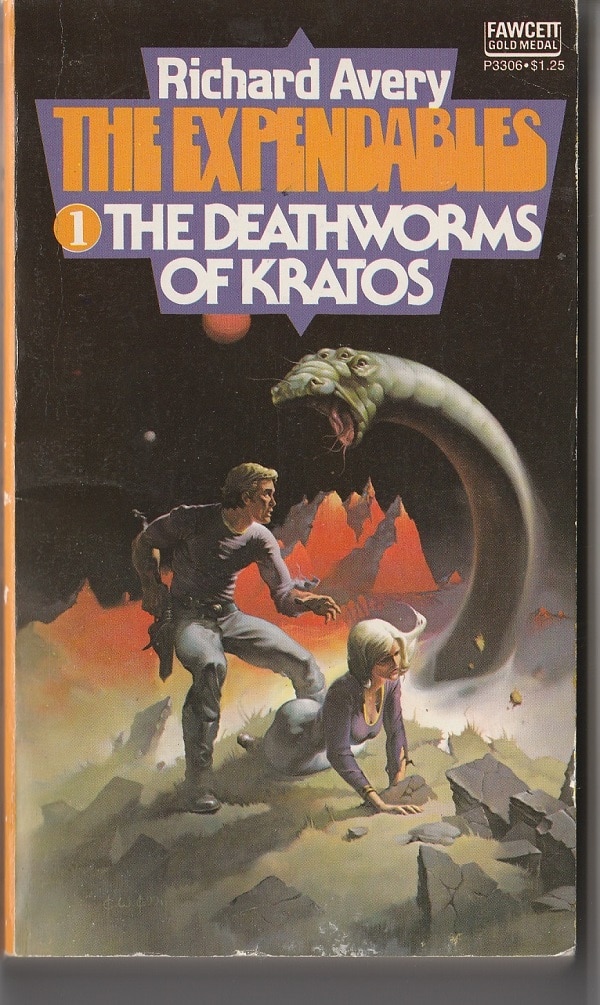There’s something deeply attractive to the idea of bad guys doing good things.
That was the idea behind the 1965 bestseller by E. M. Nathanson The Dirty Dozen, about a bunch of criminals who are recruited for a suicidal mission behind enemy lines in World War II in return for the promise of a pardon. Despite their differences, they come together as a unit and protect each other while sticking it to the really bad guys (read Nazis). A 1967 movie, based on the book, was also highly successful.
Two years later came The Wild Bunch, a western in which a group of aging outlaws take up a suicidal fight on behalf of some oppressed Mexicans.
Other examples abound over the last half century, and it leads me to wonder if there were similar stories like this during Charles Dickens’s time or Jane Austen’s or Shakespeare’s.
“Social trash”
In any case, in 1974, Richard Avery picked up the idea for a series of four science fiction books featuring a group of “social trash,” called The Expendables, who are sent into dangerous planets because it’s no loss if any of them or all of them die. His first book was The Deathworms of Kratos, a rollickingly good version of the story, set in a future that, for Avery, was a century away (2071) although, for today’s reader, it’s a lot closer.
There’s a deep element of make-believe to any of these “bad guys doing good things” stories since bad guys are, after all, bad guys who rarely turn altruistic.
Avery — who wrote a lot of novels under his real name Edmund Cooper as well as other pseudonyms — doesn’t let the reader linger too much about this fantasy-world aspect. He gets the adventure started early and keeps it going, even in the flashbacks, leaving the reader little time to ponder the unlikeliness of it all.
Deathworms and Evangelists
The novel works on a number of levels:

- The scenes are clearly and crisply drawn, as if etched sharply.
- The bad guys are really bad guys inasmuch as they are huge omnivorous earthworm-ish sorts of aliens (although, of course, on the planet Kratos, they’re the natives and the Expendables are the aliens). They are ugly and icky and very dangerous.
- The backstory of the worms is an interesting science fiction conjecture by Avery — that these worms are the equivalent of Earth’s dinosaurs. However, unlike the dinosaurs, when great climate changes came to Kratos, the earthworms — called deathworms by the Expendables — were able to survive by going underground and turning into the worm-like creatures that become huge headaches for the earthlings.
- Avery has a dry wit that shows up now and again, such as when Commander James Conrad is examining the mechanical backups for his six-member team of humans: “He lined the robots up and inspected them. Matthew, Mark, Luke, John, Peter and Paul.” Those are the names from the New Testament of the four Evangelists and the two major post-Jesus Apostles although Avery makes no reference to that.
- The Deathworms of Kratos is also rather socially and culturally advanced for its era. Three of the six members of Conrad’s team, including his deputy, are women. The smartest, most ornery and most intriguing character is Kurt Kwango, a black-skinned Nigerian-German with a history of violence including murder and rape. Other members include a Cuban, a Vietnamese-French poisoner, an American and a Welsh terrorist as well as the second in command, Lt. Indira Smith, an Indian-Anglo doctor.
“A great commercial”
For a novel of just 189 words, Avery set up a complex chapter structure that was probably unnecessarily complex. Still, it doesn’t really get in the way of this story.
Similarly, he hits pretty hard on the nasty nature of the seven people who make up the Expendables, probably harder than he had to, such as when Conrad addresses the others:
“We are all social trash, one way or another. So it doesn’t really matter a damn whether we live or die. Except that on the other side of the sky there are people who backed us, gave us what we needed, and are now waiting patiently for results. We are going to give them results — at least, the survivors are. O.K.?”
“O.K. Commander.” It was Lou Andreas who spoke. He gave a faint smile. “It was a great commercial.”
Hand-holding
No matter their crimes and unsavoriness, the Expendables are still people, and Avery keeps that fact in front of the reader throughout the book.
Early on, for instance, Conrad and then Smith are the first to be awakened from a frozen suspended animation for the faster-than-light trip to Kratos. He is showing her around the ship, and, impulsively, she takes his hand.
Indira Smith, despite white hair and prosthetic legs (or was it because of them?) was a very attractive woman, compact and graceful. But, after the trauma of jumping sixteen light-years in S.A. the sex impulse was minimal.
What mattered more was that she was a fellow human being, a companion with whom he would face as yet unknowable dangers, a vital member of the team that would either open up Kratos for mankind or, by perishing, prove that the planet was inimical to colonization.
That was why he held her hand. Because they both belonged to an elite company. The fraternity of the damned. The Expendables.
Avery has a nice touch here. And throughout the book.
Patrick T. Reardon
7.20.21
Written by : Patrick T. Reardon
For more than three decades Patrick T. Reardon was an urban affairs writer, a feature writer, a columnist, and an editor for the Chicago Tribune. In 2000 he was one of a team of 50 staff members who won a Pulitzer Prize for explanatory reporting. Now a freelance writer and poet, he has contributed chapters to several books and is the author of Faith Stripped to Its Essence. His website is https://patricktreardon.com/.
